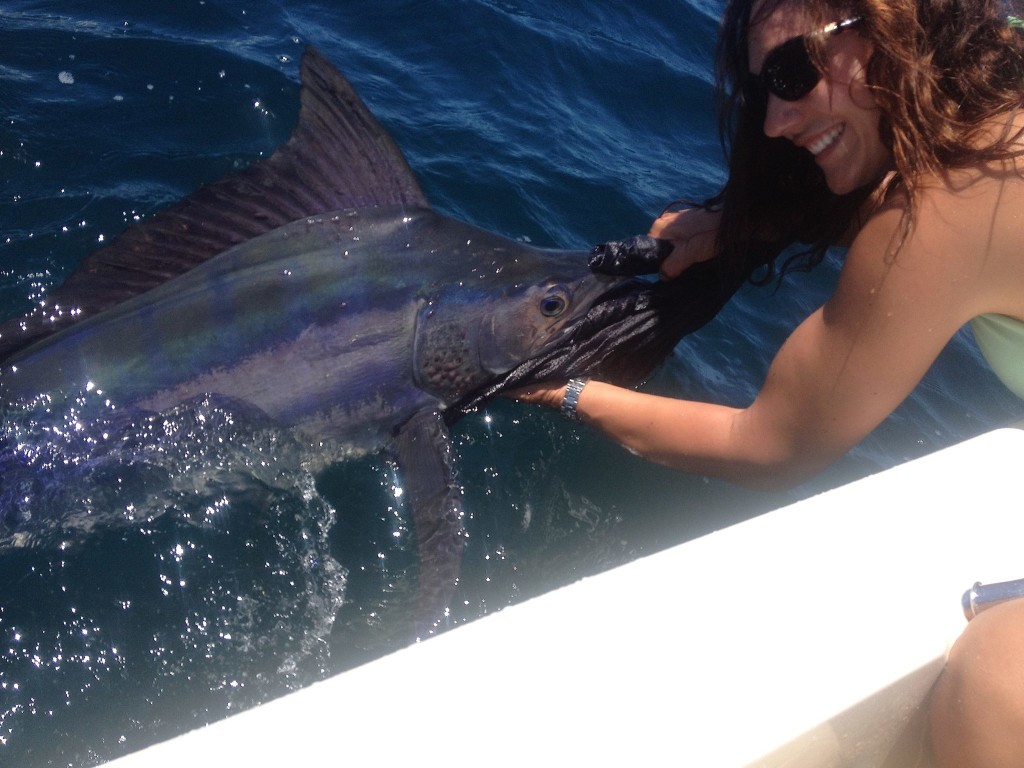I refused to troll for gamefish. The idea of casually lounging in a gas-guzzling mini-yacht, trusting deckhands to help me catch fish—all while sitting in a dentist chair? No thanks.
So I chose to stick to flats fishing instead. Flats fishing and steelhead fishing have a surprising amount of commonalities. They each require patience and an appreciation for subtleties. Mostly, though, they both require endless dedication and the acceptance that “getting a shot” is a good day.
My introduction to marlin happened when I gave up Canadian winters for Australian summers. Australia’s attractions include enormous marlin, Indo-Pacific permit, giant trevally, and short plane rides to New Zealand. Minutes from my place near Sydney, warm currents and large bait balls attract world class marlin. It was only a matter of time before I started fishing for them.
It was actually my husband’s enthusiasm for billfish that piqued my interest. I was amused by his endless excitement by them, so I agreed to give it a try. Because our boat is only eighteen feet long, it required some unique rigging. The shortage of space meant our “crew” would be just the two of us. It was when he drew me a diagram of “how to fly fish for marlin” when I realised marlin fishing is a team effort. To do this right, I was going to have to listen to him.
Since that first lesson three years ago, we’ve spent countless hours searching for marlin and equally as many hours discovering new creative ways to mess it up.

Australia is home to striped, black, and blue marlin. While dreams of landing a blue grander (a fish over a thousand pounds) often play through my head, it is the smaller black and striped marlin that are a more reasonable target. The truth is that all three of them absolutely terrify me.
It doesn’t take much more than a quick YouTube search to see how billfish anglers get themselves into trouble. Poor boat-handling aside, the sheer panic of a leaping marlin sends anglers into damage-control. A marlin in the boat is a bad outcome for everyone involved. I needed to learn the protocol before I could responsibly target one of them.
In short, chartered marlin trips come with two deckhands, a captain and a fly fisher. The captain steers the boat while the deckhands rig and troll teaser baits. The goal is to create a disturbance that imitates a school of tuna or similar feeder fish. If successful, the marlin is “called” to the surface and sets off after the bait. This is always a hectic moment of eruption, slashing, and luminescence. When billfish get excited, their bodies turn magnificent shades of blue, green, and purple.
From here, the deckhand reels in the bait before the marlin can catch up. Here’s where it gets hectic. To play by IGFA standards, the deckhand needs to rip the bait from the water, the captain needs to knock the boat out of gear, and the fly fisher has to replace the bait with a fly. In the frustration of losing sight of the teaser-bait, the marlin snaps at the nearby fly instead.
Takes are almost always visible, as most of the time they happen either on or just beneath the surface. And this is all before the fish is even hooked.
If the fish does get hooked, it proceeds to greyhound (jumps repeatedly) or sound (heads straight for the bottom). Reel drag must be set accordingly, typically backed off to accommodate the resistance of the water.
It’s understandable that not everyone “gets it” when it comes to marlin fishing. Personally, there are two reasons I keep returning to it. After spending so many years as a solo angler with a mission to escape other people, there’s something refreshing about being part of a team. Sure, a day’s float with a buddy on a steelhead river is still technically “teamwork,” but marlin fishing requires people to sync and work together on a different level. While marlin can certainly be caught as a “one-man-operation,” the fine-tuned process is best (and most safely) undertaken when several people work together. The very thought of relying on others was one of my initial deterrences, but after putting in so many hours with friends, I’ve learned to love the team-spirit.
Fly fishing is a sport of growth and progression. For some, the path leads to the mountain tops, for others it’s a trail through the valleys. For me, it’s been a long trek over peaks and shorelines… one that has landed me smack-dab in the middle of the ocean. So if you’ve been avoiding a certain type of fishing because you believe that it’s not for you, try it anyway. It might be the best chance you’ll ever take.
For a great listen on marlin fishing, check out the Anchored podcast with Dean Butler here.








